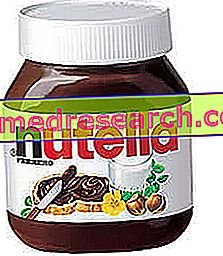Generality

It is a lipid-based spreadable cream, flavored with hazelnut and cocoa. It is a notoriously high calorie product which it would be good practice to use sporadically and not systematically; eating nutella® in large portions every day favors the increase of body fat and, in association with other risk factors, can be harmful to health.
Nutella®, like many other spreads and snacks, can be included in the category of so-called junk foods.
The peculiarity of junk food ("junk food") is to have a high caloric density, absolutely inappropriate to the lifestyle of the sedentary man, and to be in proportion rather poor in vitamins, trace elements, antioxidants, dietary fiber, fatty acids essentials etc. In other words, basing its diet mainly on junk foods, while largely exceeding the recommended daily calorie quota, many nutritional needs would not be met.
Many industrial products are included in the category, such as snacks, sweets, fast food especially if fried, sugary drinks and alcoolpops.
Background
Nutella® was born as an evolution of the Giandujot - a solid and sweet dough made with hazelnut paste from the Langhe, cocoa and sugar - created in 1946 by Pietro Ferrero (Piedmontese pastry chef).
After only two years, the Giandujot changed both name and consistency (more spreadable), acquiring the title of SuperCrema.
In 1964, Michele Ferrero (son of the famous pastry chef) further perfected the recipe and attributed the name of nutella® to SuperCrema, a noun derived from the union of the English word "nut" with the suffix "ella" (to give a sense of greater creaminess to the product). The following year, nutella® expatriated and conquered the German and French markets, thanks to its remarkable organoleptic and taste properties, as well as to a better packaging than the competition.
In 1977 nutella® reaches Australia, where an autonomous plant was set up near the capital, with which it will also expand its market to the new continents.
Ingredients
Organoleptic characteristics
" A good day with nutella®! "
" From the morning you can find all the pleasure of a tasty breakfast with nutella® "
" What world would it be without nutella®? " ...
... are some slogans that you can read on the packaging or listen to in the television programs of the spreadable cream marked Ferrero.
Obviously, the taste and organoleptic properties of nutella® are out of the question; after all, it is indisputable that this is one of the most popular sweet foods in the world.
However, will it really be a good habit to eat nutella® every morning for breakfast? The response of many nutritionists is negative.
List of Ingredients
The reasons are several but, to understand them all to the end, I will put readers in a position to read also what, usually, we tend to ignore: ingredients, nutritional composition and recommendable portion of nutella®.
Ingredients of nutella® (Italian): sugar (or sucrose), palm oil, hazelnuts (13%), low-fat cocoa (7.4%), skimmed milk powder (6.6%), whey powder, emulsifiers (soy lecithin) and vanillin.
Among the ingredients of nutella® we can note the presence of palm oil. Although, through its website, the company strives to validate this type of oil, it is a rather inexpensive product, burdened with heavy nutritional and environmental problems.
Although the company does not state the exact percentages of palm oil on the label, it is possible to make a rough estimate from the nutritional analysis of the food.
From the calculations of Verbraucherzentrale Hamburg, a German organization that deals with consumption and information, the following image was developed, which makes it clear at a glance the high amounts of sugar (below) and of palm oil (above) present in the food.

Preservatives and Dyes
| Food | % Saturated fats |
| Coconut oil | 86.5 |
| Palm oil | 49.3 |
| Nutella | 34.5 * |
| Soybean oil | 14 |
| Sunflower oil | 11.2 |
| Hazelnuts | 7 |
| * calculated according to what stated on the product label (updated on 5/11/2013) | |
Reading the wording " Without preservatives and colorings ", the consumer could feel in some way "protected" by the compositional quality of nutella®.
In reality, it is precisely the combination of:
- very low concentration of water (high energy density);
- presence of lipids in the majority saturated and well emulsified;
- considerable intake of sucrose;
- milk and whey powder
to make nutella® a real "astronaut food", not attacked by mold and bacteria.
Nutella® nutritional structure, recommended portion and GDA *
Nutella nutritional composition according to the label on the package (updated on 5/11/2013):
| Average values | for 100g | per serving (15g) | % GDA * | |
| Energy value kcal | 544 | 81 | 4 | |
| Energy value kj | 2273 | 339 | 4 | |
| Proteins g | 6 | 0.9 | 2 | |
| Carbohydrates g | 57.3 | 8.6 | 3 | |
| sugars g | 56.7 | 8.5 | 9 | |
| Fats g | 31.6 | 4.7 | 7 | |
| saturated g | 10.9 | 1.6 | 8 | |
| Dietary fiber g | 3.4 | 0.5 | 2 | |
| Sodium g | 0045 | 0007 | 0 | |
* GDA = is the daily quantity for an adult. It is based on a diet that provides an average daily intake of 2000kcal. The nutritional needs of an individual can be higher or lower, depending on: sex, age, physical activity and other factors. | ||||
Also based on the GDA *, Ferrero recommends a recommendable average portion of nutella® equal to 15g, calories 81.0, 4% GDA *.
Nutella® energy in the diet: to comment on what is mentioned in the table, an article in its own right would be necessary, but we will try to be direct and concise. Indeed, the GDAs * refer to a 2, 000kcal diet, or the contribution of a healthy adult in perfect health. He (based on needs) does not practice motor activity and, from the anthropometric point of view, does not seem to be "a giant". In this regard, it can be noted that, indeed, the recommendable portion (15g, ie a nice full spoon - what is needed to "generously" cover no more than a couple of rusks) represents only 4% of the daily energy needed . A first observation should be made on the practicability of the middle portion; 15g are very few and two rusks (with a glass of milk) are not always sufficient to quell the appetite of a breakfast (which follows a fasting of about 12 hours at night), nor the greed or discomfort attacks that often push to take the product.
Moreover, for the "real customers" of the nutella®, or rather the children and young adolescents (perhaps sedentary), who present even lower energy needs, than should the recommended portion be? Better not to know.
Simple carbohydrates and saturated fats of nutella® in the diet: the contestation of the recommendable portion continues analyzing in detail the nutritional composition of nutella®. It is therefore necessary to stop and observe two groups of very precise molecules: carbohydrates (especially simple sugars) and fats (above all saturated).
Nutella® carbohydrates are mainly simple (disaccharides), like sucrose and with little lactose. These, according to the GDA * of the recommended 15g, occupy only 9% of the total simple sugars in the diet. However, based on what is cited by the "Recommended Nutrient Intake Levels for the Italian population", on a 2, 000kcal diet the intake of simple carbohydrates should be at most between 53 and 64g for the adult (10-12% of the total energy) and between 80 and 85g for children (15-16% of the total energy).
At this point, the percentage calculation of simple carbohydrates contained in a single portion of nutella® compared to the recommended requirement for a 2, 000kcal diet, offers an interval between 14-17% in adults and 10.5-11. % in the child. Therefore the 9% indicated on the label DOES NOT seem to be correct.
Beyond the purely quantitative aspect, we recall that the contribution of monosaccharides and disaccharides in the diet MUST mainly concern the fructose contained in fruit and vegetables, and the lactose of milk and dairy products; for this reason, frequently using nutella® in generous doses it is likely to think that the nutritional balance of the diet can be compromised due to the excess of simple sugars.
Once again we should ask ourselves what kind of dietary impact could have the daily consumption of 15g of Nutella on the diet of sedentary children or young adolescents who, on average, have an energy intake lower than 2.000kcal. All readers will already know the consequences of excess sucrose in the diet; to remember some: tooth decay, glycemic changes, hypertriglyceridemia, overweight, etc.
The speech is similar for what concerns the fats contained in nutella® . The chemical analysis of lipids should be much more complex than the following but, in the absence of more precise data, we will limit ourselves to commenting only on the saturated (NOT healthy) fraction of total fatty acids.
Please note from now on that the fats contained in nutella® are excessive and also the exclusive use of the recommended portion does not facilitate the maintenance of a healthy and balanced diet. Having said this, based on the table, the amount of saturated lipids contained in the 15g portion (1.6g) is estimated at 8% of the GDA *.
As mentioned in the "Recommended Nutrient Intake Levels for the Italian Population", saturated fatty acids should not exceed 10% of the total energy, appropriately contextualized in 25-30% of TOTAL lipids.
This means that, in a 2, 000kcal diet, the total energy fats should be between 55.6 and 66.7g / day, while the saturated ones should NOT exceed 22.2g / day. The accounts come back this time compared to the GDA of the label, but that's not all! It is well known that saturated lipids represent a typical component of foods of animal origin; this means that, theoretically, their intake in the diet should be regulated by the intake of milk and derivatives, meat, eggs and fish. According to the dietetic logic, these latter foods are indispensable to the achievement of the quotas of: iron, calcium, phosphorus, water-soluble B vitamins and liposoluble vitamins (A and D), as well as high biological value proteins.
It is therefore logical to think that it is NOT correct to "adjust" the total intake of saturated lipids by reducing the portions of these foods to favor the intake of nutella®. This is as true for the adult as it is (and even more) in reference to children and young adolescents. On the other hand, ignoring the intake of saturated fats or even just the total ones in the diet could have consequences of: hypercholesterolemia and weight gain in the fat mass.
We always remember that what described above refers exclusively to the recommended portion (1 generous spoon) of nutella®; increasing it (widespread behavior), nutritional imbalance would increase further.
Nutella® VS other spreadable creams
Nutella® is certainly an Italian "myth"; its consumption is given a real social phenomenon. This does not detract from the "pearl" of the Ferrero company, which is struggling to keep up with other competitive spreads. Let's see why.
Among the raw materials used to make the spreads, hazelnuts, cocoa and cocoa butter should prevail.
As we mentioned in the previous paragraphs, a rather vague voice appears in the nutella®: vegetable oil. Since cocoa butter is a rather prized (and expensive) fat, using it in the formulation of a spreadable cream would have as a logical consequence the relative quotation on the label; but this is not the case with nutella®. To be honest, it is not that from the chemical (and metabolic) point of view one and the other ingredient differ substantially; indeed, some vegetable oils have a better ratio of fatty acids than cocoa butter itself. The only problem lies in the fact that it is not possible to establish the real wholesomeness of nutella since its quantity of monounsaturated and polyunsaturated fatty acids is unknown, and above all the possible method of refining / processing applied to the oily raw material.
On the other hand, the percentage of hazelnuts contained in nutella® is rather clear; comparing it with that of other spreadable creams (the most famous ones) Nutella disappoints a lot, with a deviation of -32% compared to the best range (which we will avoid mentioning).
The amount of added sugar also represents a discriminating element. Recall that an excessive perception of the sweet in foods tends to "mask" other potentially deficient or unpleasant scents. Nutella® is one of the spreadable creams that contains it (> 50% of the total weight) and one reason is certain. The doubt arises that Ferrero's marketing power (to say the least colossal) can more than satisfactorily compensate for the quality competition of other brands, demonstrating (haimé) the ignorance of the average consumer.
Nutella-type spreadable hazelnut cream
X Problems with video playback? Reload from YouTube Go to Video Page Go to Video Recipes Section Watch the video on youtubeObviously, in the comparison of spreadable creams we deliberately exclude the "price" variable (not relevant to the reading objective); these days, you know, better "tighten the boundary" and, to your advantage, nutella® is not the most expensive product on the market, far from it! Compared to new higher quality products, nutella® saves almost half the final price.
As if to say, Ferrero knows a lot! With a product that perfectly suited the commercial demand of the 1960s, it continues to prevail on the market. Using basically less valuable raw materials than the most renowned (and expensive) competing new products, the leading company has been able to invest in brand consolidation by penetrating the habits of Italians to the point of no longer needing to compare with rival companies. To summarize the influence that nutella® has obtained on recent generations, just think that in a statistical note it was mentioned among some of the "reasons of life!"



